
INTERVIEW: with Alan Streets, Outsider Artist
“These artists are inventors of a private world, not in dialogue with art history but in conversation with their own visions and emotions.”
— Sarah Lombardi, Director of Collection de l’Art Brut, on outsider artists.
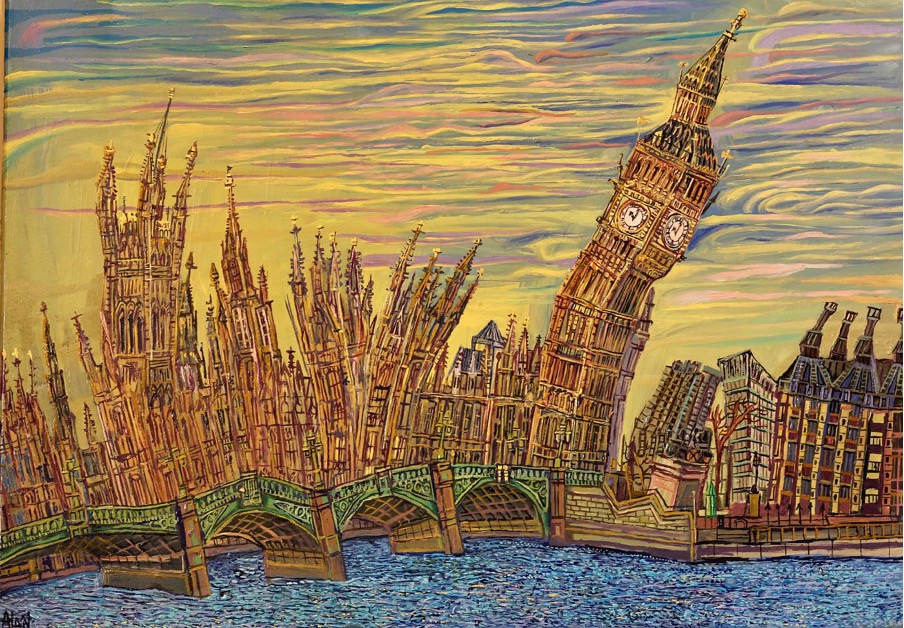
London, opposite Parliament. Alone by the Thames. Westminster Bridge slithers by the clock. Gothic towers pitch and bend, twisted expressions of crooked deals. Big Ben bows in shame, turns to weep beneath a melting nicotine sky.
We have entered the world of Alan Streets, a quasi-reality that denies the existence of “normal” perception.
Tourists of Alan’s world are shown instinctive, fantasy caricatures of cityscapes, country lanes, chance encounters. We see familiar places through a synaesthetic lens that gives colour and shape to sound and feeling. Instead of the disquieting thrall of déjà vu, we experience a vivid comic book reimagining not just of scenes but of emotional states; the very essence of a place, with its own peoples, palettes, and perspectives.
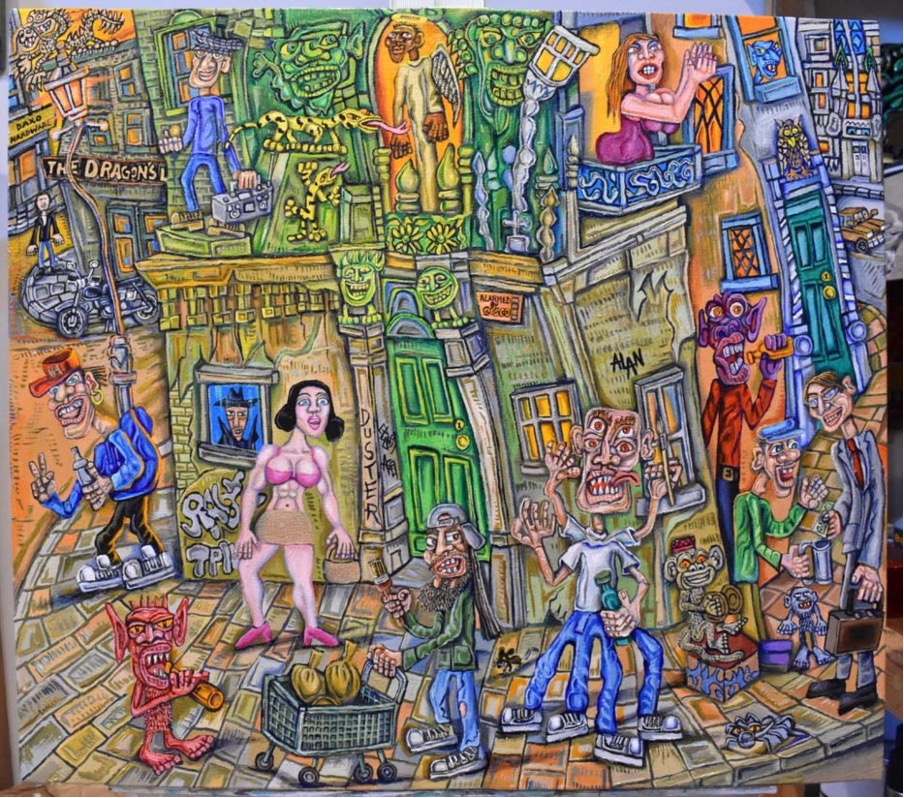
Born in Roehampton in 1969, Alan Russell-Cowan has painted obsessively since the age of 8. After a brief and disagreeable stint at Central St. Martin’s, Alan took his skills to the streets of New York where he was later diagnosed with schizophrenia. Here began a long-term on/off relationship with medication, and two further transatlantic relocations. In spite of such chaotic undulations, Alan never stopped painting.
Josefus Haze caught up with Alan to find out more about his transition from middle-class art school dropout to ferociously prolific outsider artist.
NB – This interview was conducted via email over the course of several weeks. Alan has a tendency to capitalise certain words that others may not. Instead of “correcting” these during the editing process, I have left them in situ as a further example of Alan’s artistic sensibilities. These capital letters seem to say something about what Alan finds important, and I feel about as qualified to alter them as I feel qualified to take his brush and edit his paintings.
Josefus Haze – What is art and what functions does it serve in both the artist and the viewer?
Alan Streets – Art is a way for an Artist to communicate his own visions and ideas to the masses in a way that is simple or confusing or sometimes a mixture of both.
Art is something that should provoke an emotional response in the viewer, either negative or positive. If it doesn’t move the viewer in some way, then it is not Art!
The function of creating Art, for an Artist, is a method of self-catharsis.
If an Artist doesn’t create Art frequently, then if he is a true Artist he will start to feel sick and unwell.
Art for Artists who are fortunate is a means of earning a living.
Creating Art for an Artist for the most part is fun and a way of life!
Art for the viewer is a way in which he can relate his own inner experiences and emotions via the particular piece of Art that he is viewing!
JH – In your book, The Schizophrenic Experiences and Psychosis of Alan Russell-Cowan, you describe how your symptoms began around age 17, after playing the Ouija with some friends. Had you experienced symptoms prior to this or did that experience bring about a distinct change?
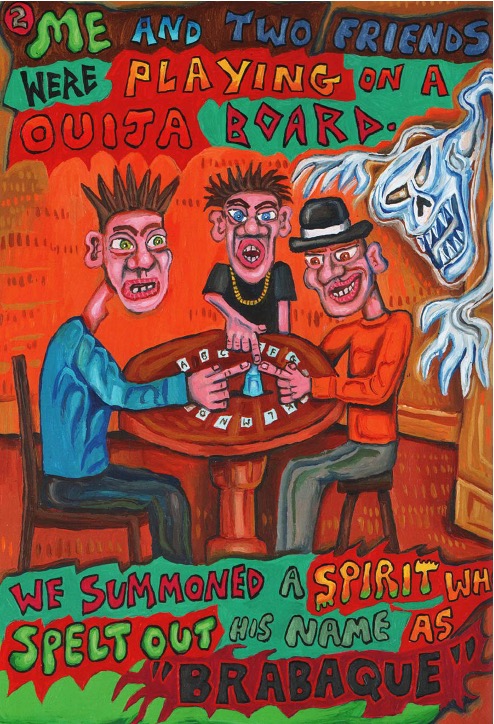
AS – I had experienced a few symptoms prior to playing on the Ouija board but my memory is vague. My problems and schizophrenia really started after I played on the Ouija board.
JH – Did either of your friends experience any fallout?
AS – My friends were ok and went on to live normal lives, get married, and have families.
“We live together, we act on, and react to, one another; but always and in all circumstances, we are by ourselves… From family to nation, every human group is a society of island universes.”
– Aldous Huxley, The Doors of Perception
JH – A big influence on your trajectory as an artist were the feelings of disillusionment and disenfranchisement you experienced at St Martin’s, supposedly one of the best places a budding artist could begin their career. What was the landscape like during your time at the college, and do you remember a specific moment that made you realise you didn’t fit into that system?
AS – I was only eighteen when I went to St. Martins on a Foundation Course. I was more into smoking cannabis than learning, as I had been to a Public School and studied O levels and A levels, and my mind couldn’t take any more pressure and learning. I think then that my mind just couldn’t cope and spurred on by cannabis and the first signs of schizophrenia I was unable to function properly. This inevitable demise of my learning ability caused me to drop out.
There were a lot of parties, and I was also heavily drinking. My mind was stuck in a rut and not developing naturally so I had no other choice but to leave.
One of the major problems I had – and still have – is I can’t stand people telling me what to do. I was uncooperative in following the Art Teachers’ instructions. At that time, I was lazy and only interested in partying and getting stoned.
Also, I didn’t have an adequate Student allowance on behalf of my parents. I was always broke and anxious about money, so this made it impossible to work hard and try and please my parents.
I got a part time job painting leather jackets at Kensington Market and sometimes I would take these jackets to St. Martins and paint them there.
If I’d have had a proper loan and Student allowance then I think I would have finished the course and stayed at St. Martins, maybe even graduated with a Degree. At the time it was all about money though and I didn’t have any, so I left!
It was a crisis of funding that forced William Blake out of art school and into an apprenticeship as an engraver. Several years later, while at The Royal Academy of Arts, Blake bucked against the establishment’s insistence that he study the work of Rubens, preferring to admire the Renaissance art his teacher deemed “stiff and unfinished”. History and literature teem with examples of ‘student vs master’, which leads one to suspect that ‘artist vs art establishment’ is a tug-of-war as old as art education itself. Like Blake, Alan Streets determined to tread his own path.

JH – At 19 you moved to New York. What attracted you to The Big Apple?
AS – It was an interest in Graffiti from seeing the film “Style Wars” when I was 16 years old that drew me to New York. I wanted to prove to my family that I could succeed and do something, so when I arrived in New York I was fortunate and was hired to paint some murals in various Nightclubs.
I was ambitious and wanted to become a famous Artist and make a name for myself, really be a somebody instead of a nobody. Now I’ve changed and I’m not concerned about the pursuit of fame at all, after having had a taste of it with the Documentary that was made about me. I wouldn’t recommend being famous to anyone! All you need is enough money to survive and live a regular life without trying to be a somebody, that way you’ll be far happier!
JH – This was during the golden age of hip hop. What was the city like back then for an aspiring artist?
AS – Well, it was exciting for a young newcomer from the London suburbs. It was also mean and terrifying. But there was money there amongst all the dirt and grime.
There was hope and opportunity for aspiring artists that could never be found in England, well as far as I was concerned, in America I was in with a chance to succeed as an Artist. In England I had no chance!
New York in 1988 was completely covered in Graffiti. There were throw-ups and tags everywhere.
It was rough, fast paced and intimidating. It was wild. People smoked marijuana openly in the Street and tripped on Angel Dust. There were Grateful Dead Hippies – “Deadheads” as they were known – selling LSD tabs. There were groups of Punk Rockers sitting on stoops at St. Marks Place sparing for money for beers. And everywhere you looked there were these crazy Homeless characters running around holding paper cups and begging.
New York back then was ungentrified and chaotic. You would see Hip Hop culture everywhere there. Hoodlums wearing heavy gold chains and sporting loads of jewellery. It was like in the movies but real.
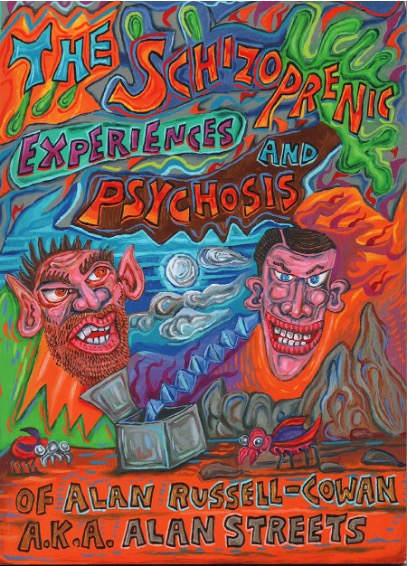
I had only been there for about a few weeks when I landed my first job to paint a mural in a Nightclub called Johnny Rockets. This was a dream come true to be able to paint such a large mural and get paid to do so.
So, I lived in New York at that time for 2 1/2 years until 1991. I used to sell my paintings on Broadway by Tower Records. There would be other Street Hustlers selling Hip Hop mix cassettes and homemade African style Hip Hop jewellery. It was very interesting and inspiring. But then they got rid of the Mayor David Dinkins and put Giuliani in charge. He was terrible and clamped down on all the illegal street vendors, confiscating their merchandise.
At that time, I was also hired to paint all the artwork for a Nightclub called The Far Out Lounge, on the Upper East Side. This was a golden opportunity and something that could really almost only be dreamt about, rather than actually being a reality.
I was very lucky for the opportunities that I had been given there but my alcoholism and underdeveloped mind was unable to cope with the success that I did have!
JH – During that first stint Stateside, you checked yourself into Bellview where they administered drugs you later said took away your personality. Having spent significant periods both on and off various forms of medication, where do you now stand on the subject of art therapy vs conventional therapies and medicines?
AS – I think that conventional Art Therapy works well when combined with medication, but it is not a cure for Mental Illness by itself without medication. I didn’t take any medication for about 10 years from the age of 30 until 40 or so and became more and more unwell and mentally unbalanced as the years progressed.
At the end I was a sick, out of control maniac, and by some miracle I was able to be put back on medication which has probably saved my life or stopped something really bad from happening.
Despite the Documentary having been made about me and my life without medication, I think that I should have kept taking my medication and tried to stay away from the Limelight.
I would advise anyone who has been diagnosed with schizophrenia to take their medication as I have been doing daily since 2012.
There are lots of difficulties with psychiatric medication, but it is a life saver and keeps patients out of long term stays in Mental Hospitals!
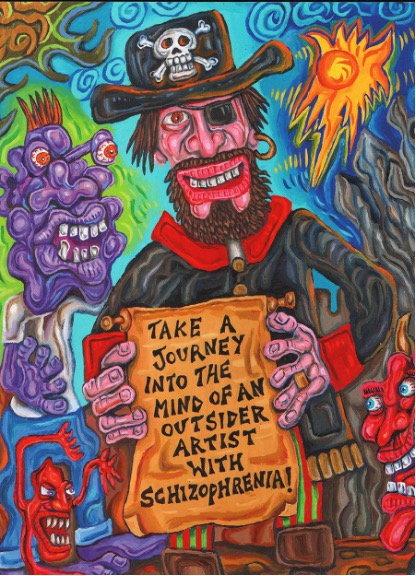
JH – Does your output change when you go with or without medication?
AS – I was slightly more productive during the years that I was off medication because I had far more energy. One of the drawbacks of medication is that it takes away a certain amount of energy, but I am still very productive and work for at least 9 hours every day during the week and 6 or 7 hours on Saturdays and Sundays. Creating Art, I find is enjoyable and not really work when compared with having to do everyday tasks such as cleaning or going to the Supermarket.
JH – Thinking back to your days at St Martin’s, you were forced to make the pragmatic decision to halt your studies in favour of earning an immediate living from your art. In a world that imposes these choices upon people, is it only a privileged few who can make art for art’s sake?
AS – The Gallery that represented me in the 1990’s didn’t sell enough of my paintings for me to earn a living. I became very frustrated and went to America again. Out of desperation and survival I began painting plein-air on the streets of New York. This was why I called my website Alan Streets and how I became known by that name. I began to succeed and earned money from selling my plein-air paintings and it was this money that allowed me to be able to afford to experiment with mosaic tiles, etc.
It really is for the most part only the privileged few that can make Art for Art’s sake, as they have the money to spend on art materials, and because they are privileged and wealthy, probably being represented by Blue Chip Art Galleries and selling their work for high sums of money. So, because of this they are able to experiment with different Art forms and be more creative. Experimenting for Artists is about the cost of the Art materials and the amount of spare time that the Artist has.
JH – How do you think we as a society might change that?
AS – The best way that we as a society can make creating Art more accessible to poorer people is by making the Internet system much fairer. At the moment the Internet is all based on money and greed. 15, 20 years ago normal Artists could earn money from the Internet just by having a good website. Now it is virtually impossible to succeed.
Now you have to pay a lot of money for promotion and advertising etc.
The system is now unfair and only geared to supporting the rich.
Most of the people in society because of this become despondent and give up on the idea of being an Artist!
“It is hard, terribly hard, to keep on working when one does not sell… They are building state museums for hundreds of thousands; meanwhile the artists can go to the dogs.”
– Vincent van Gogh
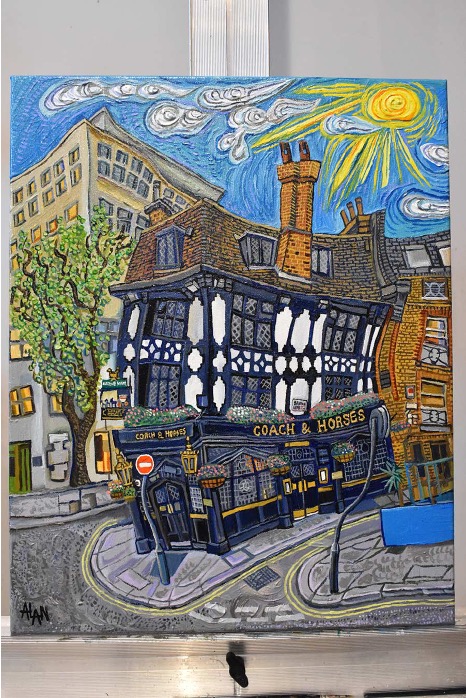
JH – Why do you think people in the UK don’t tend to buy as much as people Stateside? Do you think your style is more in line with the New York sensibility or are there simply more people there who can afford to buy an artist’s originals?
AS – I think that this all stems back to Henry Vlll, the Church Reformation and the Dissolution of the Monasteries, and the destruction of all that wonderful Christian Art.
People in England, or huge swathes of the population have been conditioned to loathe Art and Artists. Art is something for them to be kept down and destroyed, and that is the main reason why so many people in the UK don’t buy Art.
The Puritans colonized America to get away from that controlling Government mentality so American Society and American people have evolved with a different mindset and mentality to those of the English. Americans like and appreciate Art and Artists to a much greater extent than the British and this is because of the difference in History and Culture of the two different countries!
My style of Art – which is Graffiti influenced Lowbrow Outsider Art – fits in with the New York sensibility and this is why to a certain extent I succeeded when I lived there. Also, in America there are more potential customers with a disposable income who can afford to buy an Artist’s Original!
Outsider artist is perhaps a poor description, for creators like Alan do not exist outside of society as much as they stand directly at its centre, with humanity and its machinations spiralling around them like the spokes of a wheel. Modernity’s vehicle accelerates with ever increasing velocity. We on the spokes move at such a pace as to blur all but the narrow wire of our own existence. At the centre, alone on their tiny island, the so-called outsider artist sees all and interprets from within.
JH – What attracted you to wood carving and how have you found the transition from brush to chisel?
AS – Well the story of how I started Woodcarving began when I was Living in East Ham.
I was about 40 years old at the time. One day I was walking past this building site and there was a big pile of wood and bricks etc. I dug out a few pieces of mahogany or it could have been walnut, and I took them back to where I was living. A few days later I went to a specialist Art Shop in London and bought some metal etching woodcut tools to maybe try and carve something in the wood. So, I began carving a swallow in one of the pieces of wood and it turned out really well, I thought, for my first ever attempt.
I decided to actually try woodcarving properly with chisels and big blocks of wood. So, I went to another specialist shop for Sculptors and bought a whole set of woodcarving chisels, and then I went to a Timber Yard that stocked rare hardwood for woodcarvers, and I bought loads of blocks of wood and had them delivered, and then I wholeheartedly began to wood carve.
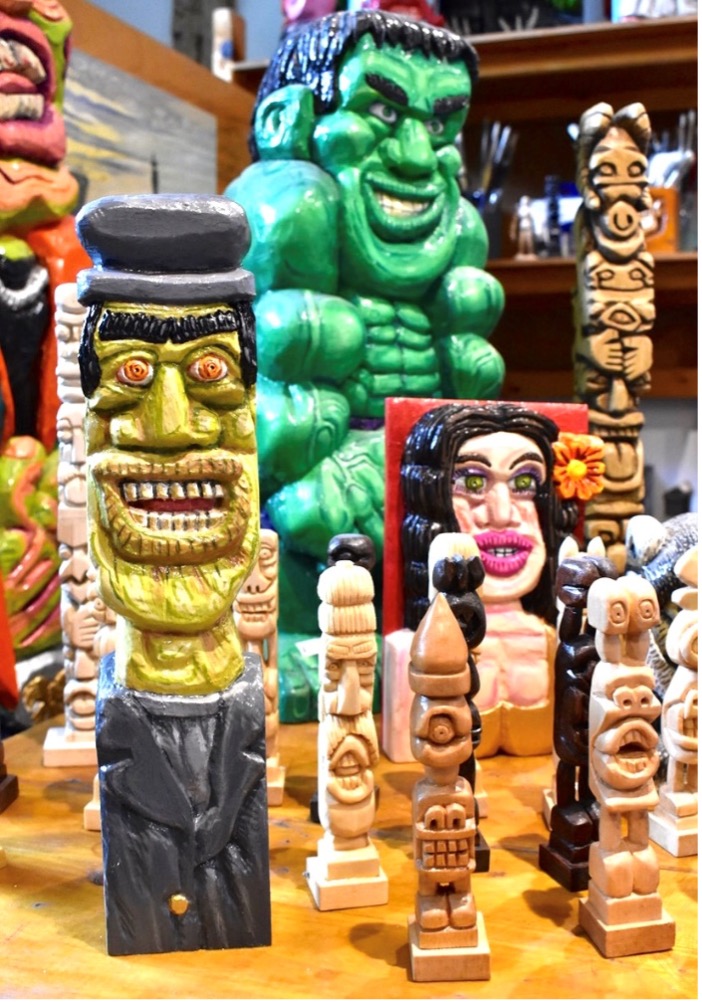
I took to it like a duck to water, although I’ve never had a formal lesson, and I created my first collection of woodcarvings. About a month later I sold one at Brick Lane Market where I had a trading licence. It was the head of Neptune and sold for £50.
I’ve been woodcarving on and off for the last 14 years. It is my hobby and not my chosen profession, so there has been no real transition from brush to chisel.
It is just something extra that I have learnt how to do, and as I have now created a large collection of woodcarvings, eventually it should make my entire inventory of paintings more valuable, especially after I am gone!
JH – Are there any other artistic practices that interest you?
AS – Absolutely! When I was about 40, just before I left New York after 9 years, I started experimenting with Mosaic tiles. The Art shops in America were a lot more well stocked than those in England, so I was able to get hold of all kinds of different Mosaic tiles and also the tools to shape them.
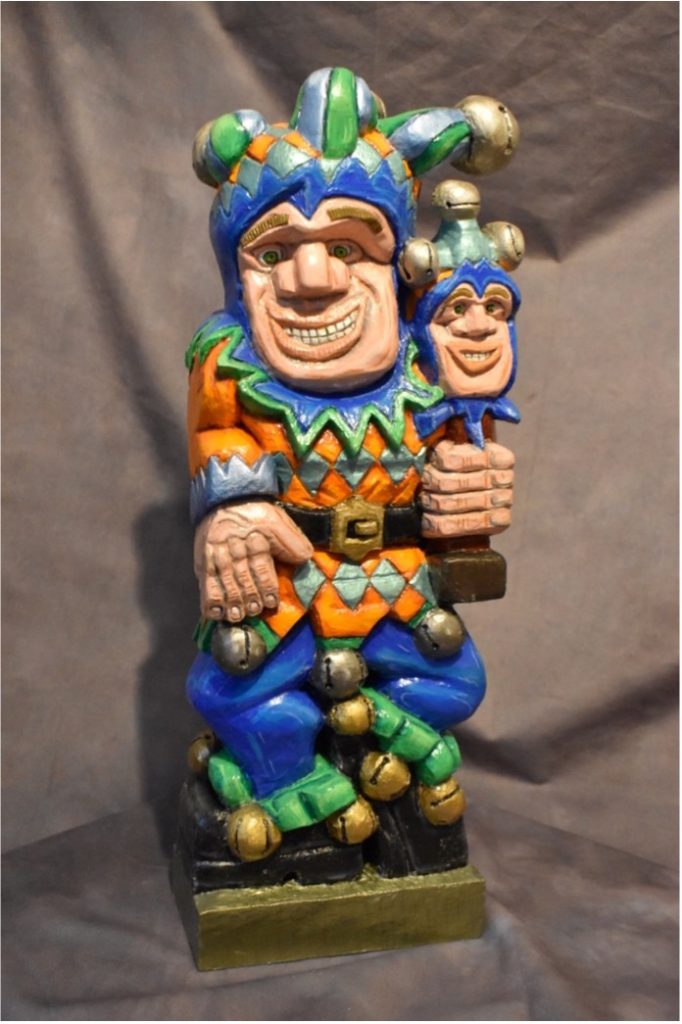
I started experimenting. I would use Liquitex or Golden paste and then stick them in the paste on top of the canvas within paintings. I also made some Mosaics using plyboard as a base. I was also hired to paint a mural in an office, and I incorporated Mosaic tiles into the mural. If I had stayed in New York more, this would have been something that I really would have gotten into.
Right before I was sectioned and put back onto medication, I had spent 9 months living in a Hotel room in the centre of San Francisco. This was where I started to wood carve more in my spare time, but I also began to experiment with aluminium wire sculpture, hand engraving with gravers on copper sheets, and also stone carving, which was fascinating. The only thing that I didn’t like about stone carving was the mess that it created with all the dust and constantly having to wear a dust mask. But the vibe of carving into different types of stone is amazing.
I carved in soapstone, granite, and also some boulders that I had gotten from the beach. But after coming back to England I decided and realised that I prefer woodcarving to stone carving.
I have also experimented with clay sculpture, but I found that clay wasn’t for me. I didn’t like the messiness and stickiness of working with clay.
I’ve decided now just to stick to painting and woodcarving!
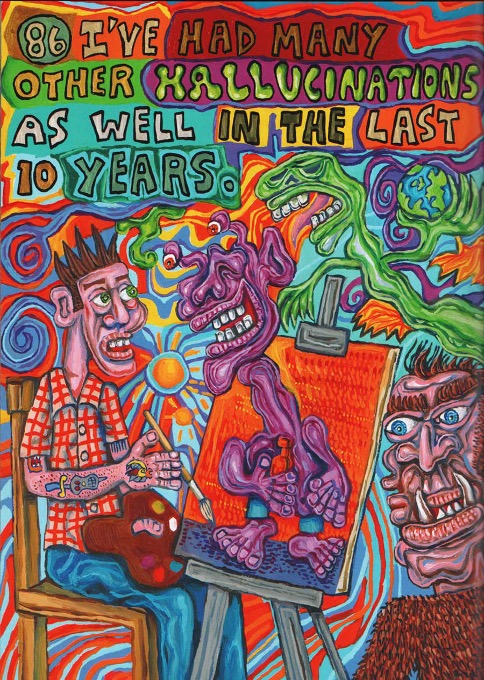
Why are some artists so prolific? What prevents the wellspring of their creative impulse from drying up? Though Stevenson used cocaine to write Jekyll and Hyde in ten days, he was very much the fertile writer when not imbibing. From Pablo Picasso to Alice Flaherty to our beloved Vincent, some seem born with the psychogenic cocaine of artistic hyperactivity.
JH – In the documentary My name is Alan, and I paint pictures, you said you wanted to paint more pictures than any artist who ever lived. Almost 20 years on, do you still feel the same urgency to create?
AS – I always feel an urgency to create and I feel sick if I don’t, but when I said 20 years ago that I wanted to paint more pictures than any Artist that ever lived, I think that I had said that because I was deluded and hadn’t been taking my medication for so long. I think that that was an unrealistic, almost stupid and egocentric thing to say.
I’m pleased with myself now; in that I don’t think like that anymore. I’m comfortable just living day to day without trying to be a bigshot or a somebody. I do though take pride in my work, and I like to be able to say “Yeah, I did that!”, in regard to Art that I have created.
If a day goes past where I don’t draw, paint or wood carve then I do start to feel unwell and the best quickest way to make myself feel better in those circumstances is to draw in my sketchbook the inner angst that I am experiencing!

It took a lengthy internet search for me to find the documentary, a search made more frustrating when the one I found ended abruptly at 59 minutes. Impulsively, I wanted to ask Alan where I could find the entire film but was dissuaded by his obvious distaste for the spotlight. To be denied the documentary’s conclusion feels more authentic, truer to life, as though the rolling credits would have been the glass come down over a framed butterfly.
Consider the entre body of work created by Alan Streets – from the painted leather jackets of his college years, through all of his paintings, to his most recent woodcarvings – and one thing that hits you is that his style has not changed, he has simply gotten better at executing it. Parallel to and indivisible from the trajectory of his artistic learning curve, runs that of the personal trials and triumphs through which he has – with proper medical support – gotten better at being himself.
JH – Today’s young artists have grown up in a media-driven world that tends to equate success with fame and fortune. What advice would you offer them on how to maintain amidst the chaos?
AS – My personal experience with fame was when the documentary was made about me which was released in 2007. This film made me very unhappy, as I had been filmed saying a lot of foolish statements which caused very many people to take offence towards me.
If I had another chance, then there is no way that I would allow for a documentary to be made about me. I wouldn’t recommend the pursuit of fame and being in the limelight to anyone. It’s better to remain anonymous. Just work hard and take pride in your individual work.
I would advise young Artists to try and do what makes God happy by trying to follow what the message in the Bible is, without being obsessed by money and fame!
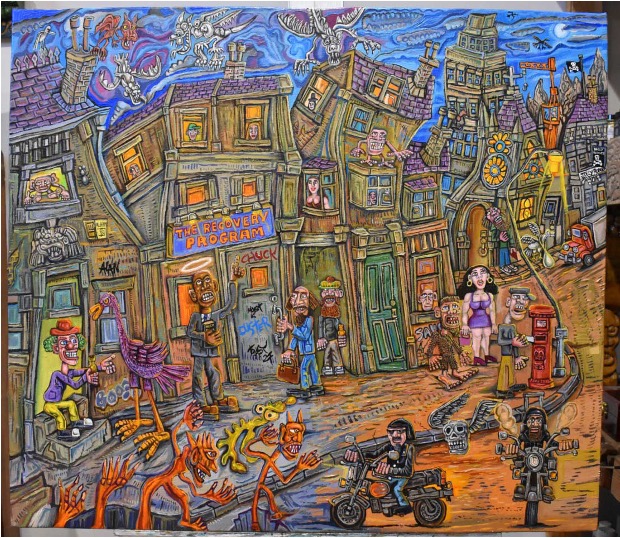
Though this was to be my final question, I was surprised by Alan’s statement about God and The Bible. When asked for more detail, his response was succinct and to the point.
AS – Religion is a very difficult topic to talk about, as there are so many different views and beliefs. This is all I would like to say about my own personal beliefs: Schizophrenia is a scary, debilitating illness, and I became Religious and started praying to Jesus because I was tormented.
I read the Bible daily and I think that this book can help people to find guidance in the answers to everyday life!
Though we may not view it through the schizophrenic lens, most of us are acutely aware of the seething maelstrom of everyday life. In our secular world, we seek to quiet our minds through forms of meditation, reading, the Tarot, immersive games, and other such mind-focusing pursuits.
I am reminded of the young van Gogh’s ambition to become a clergyman. Perhaps therein lies the true profession of the outsider artist: to paint sermons of the world as it is to them and no one else. Perhaps therefore if we collate his many paintings, carvings, and sketches, and compile them into a single document, we will have The Gospel of Life According to Alan Streets.
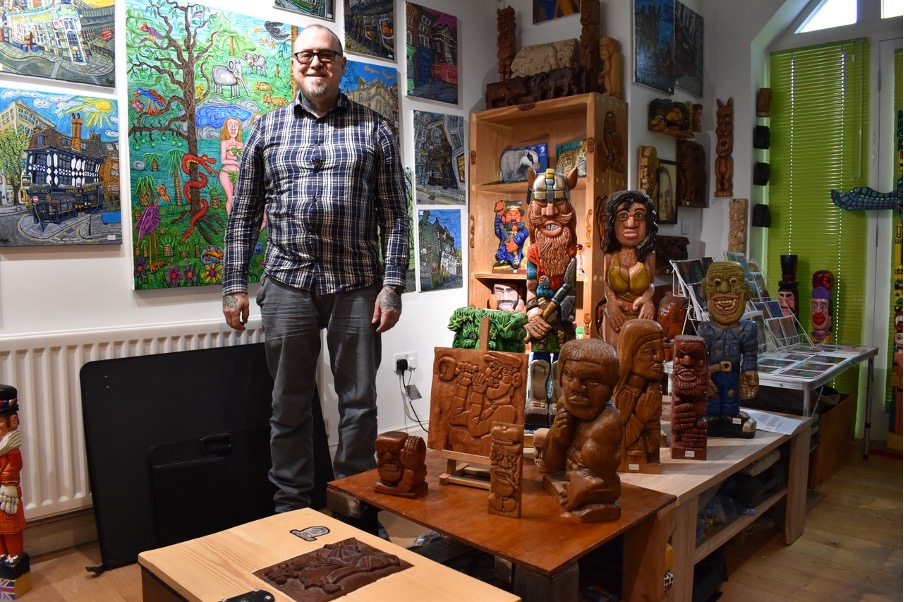
“…and then I have nature and art and poetry, and if that is not enough, what is enough?”
— Vincent van Gogh
Back to home.